
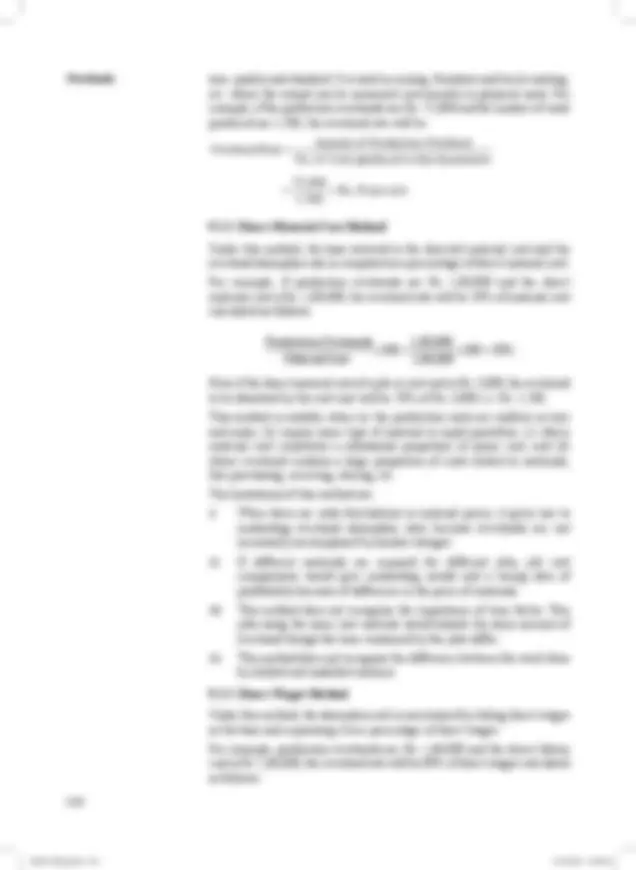
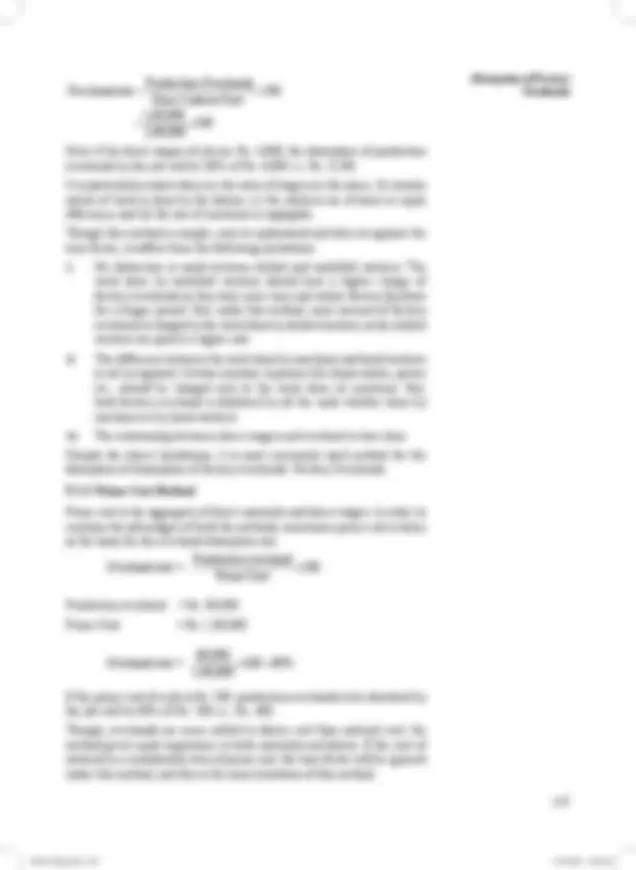
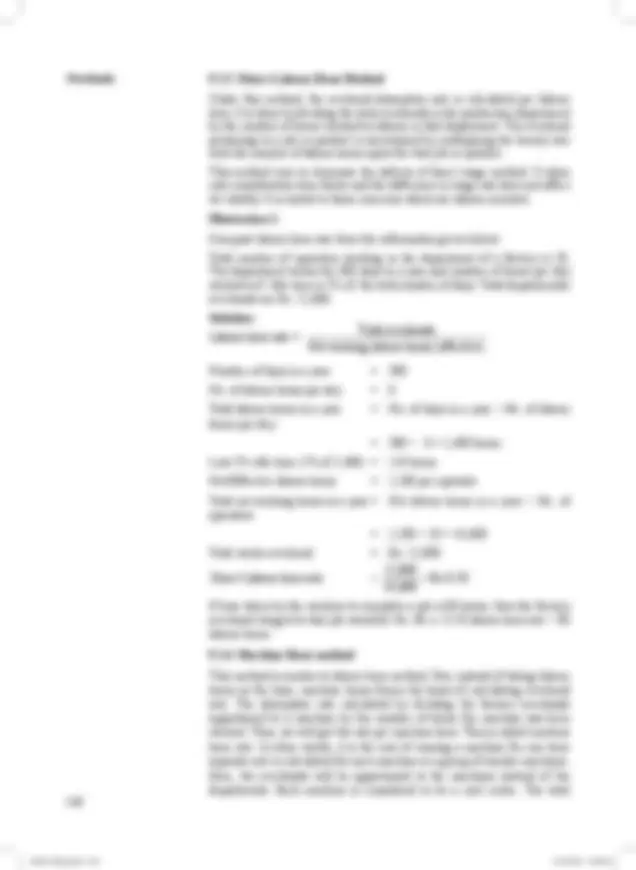
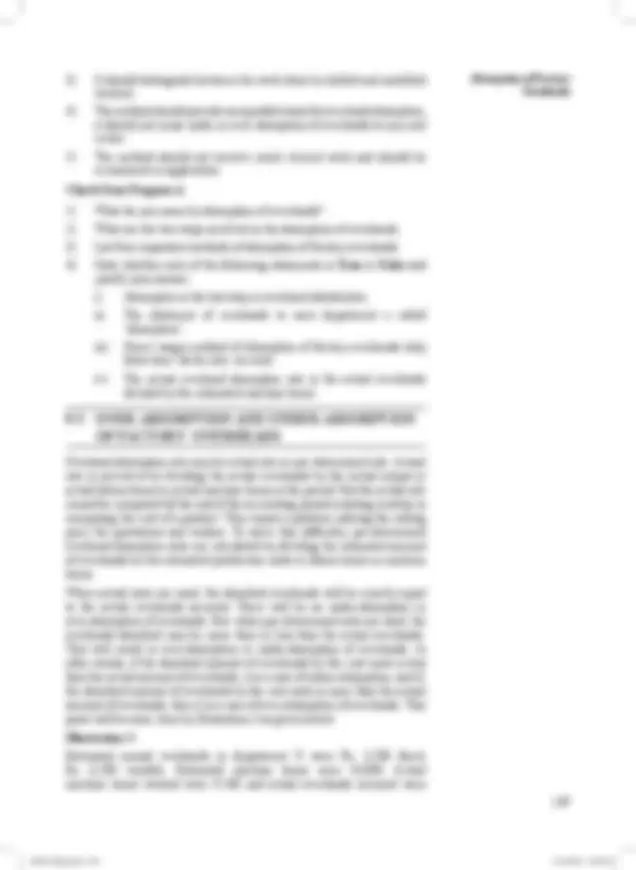
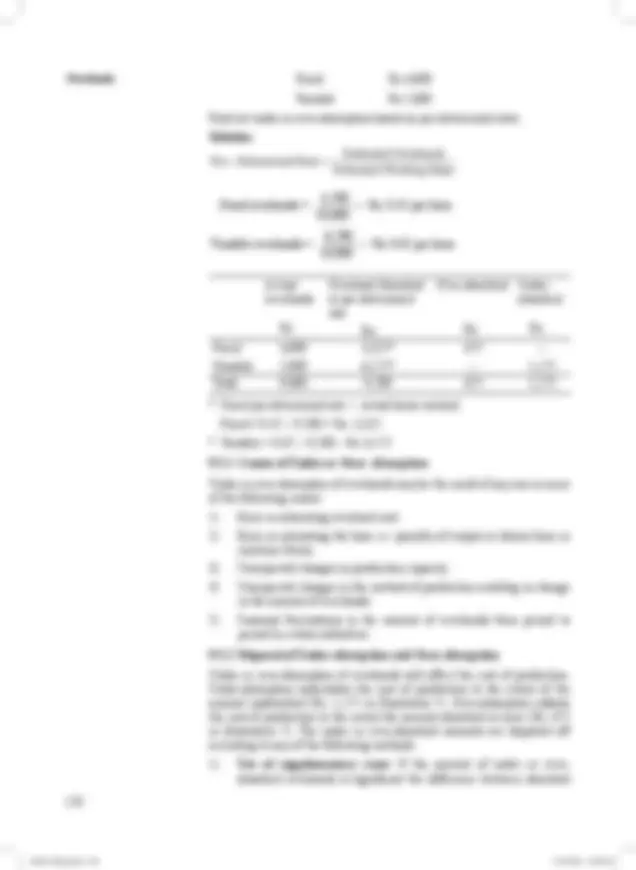
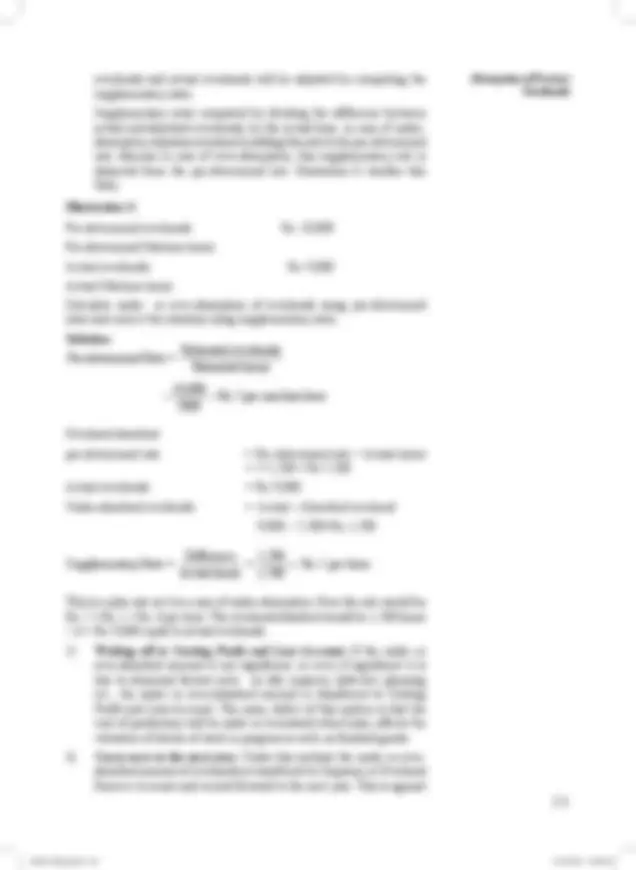
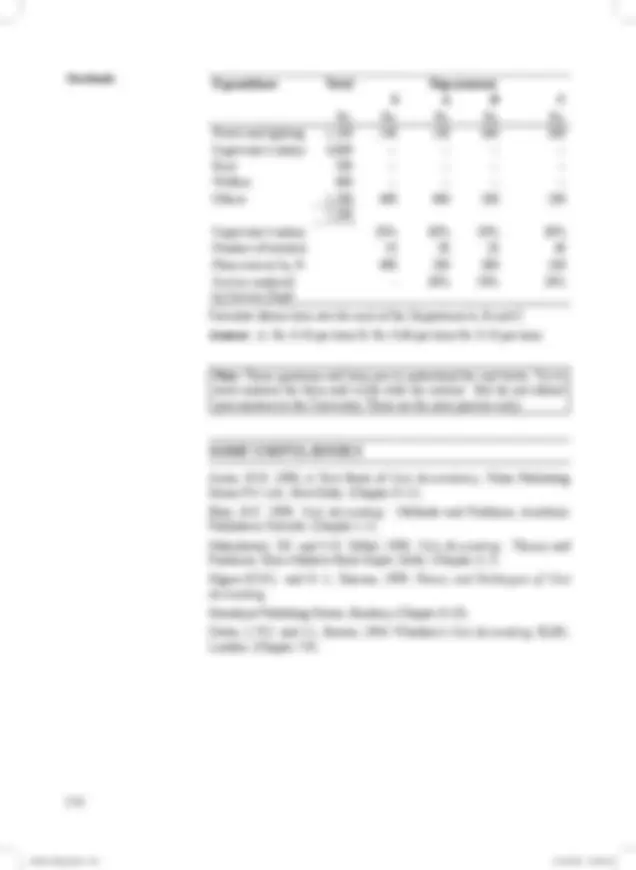


Study with the several resources on Docsity

Earn points by helping other students or get them with a premium plan


Prepare for your exams
Study with the several resources on Docsity

Earn points to download
Earn points by helping other students or get them with a premium plan
Community
Ask the community for help and clear up your study doubts
Discover the best universities in your country according to Docsity users
Free resources
Download our free guides on studying techniques, anxiety management strategies, and thesis advice from Docsity tutors
In this unit, you will study the various methods of absorption of overheads their merits and demerits, calculation of overhead rate under each ...
Typology: Study notes
1 / 13

This page cannot be seen from the preview
Don't miss anything!








Overheads
Structure
9.0 Objectives
9.1 Introduction
9.2 Meaning of Absorption
9.3 Methods of Absorption
9.3.1 Production Units Method
9.3.2 Direct Material Cost Method
9.3.3 Direct Wages Method
9.3.4 Prime Cost Method
9.3.5 Direct Labour Hour Method
9.3.6 Machine Hour Method
9.4 Requisites of a Good Method of Absorption
9.5 Over-Absorption and Under-Absorption of Factory overheads
9.5.1 Causes of under or over-absorption
9.5.2 Disposal of under and over-absorption
9.6 Let Us Sum Up
9.7 Key Words
9.8 Answers to Check Your Progress
9.9 Terminal Questions/Exercises
After studying this Unit, you should be able to:
● explain the meaning and need for absorption of overheads;
● describe different methods of absorption and their relative merits and
demerits;
● decide on a suitable method of absorption; and
● explain the meaning of over-absorption and under-absorption and
their treatment in cost accounts.
In Unit 7 you learnt about the first three steps in overhead distribution viz,, (i)
collection of overheads. (ii) allocation of overheads, and (iii) apportionment
of overheads. You also learnt about the preparation of overhead distribution
summary whereby the cost of operating each production department could
be ascertained. You know that the basic purpose of this exercise is to
ultimately distribute various overheads to different products manufactured
in the factory. For this purpose, another step in overhead distribution is
followed. This is termed as absorption of overheads. In this unit, you will
study the various methods of absorption of overheads their merits and
demerits, calculation of overhead rate under each method, and the treatment
of over-absorption and under -absorption of overheads in cost accounts.
Absorption of Factory
Once the total overhead cost of various production departments is ascertained
by means of allocation, apportionment and re-apportionment, these costs
should be charged to the cost units i.e., the products that pass through these
production cost centres. As the ultimate objective is to find out the cost of
production it is necessary to distribute the overhead costs of production
departments/cost centres to the cost units.
This process of charging or apportioning the overheads is known as
‘Absorption’.
The total overhead cost of a production cost centre consists of:
i) its own indirect cost e.g., indirect materials, indirect wages,
depreciation of machinery etc. (allocation);
ii) a share in expenses common to various departments e.g., factory rent,
power and lighting, building insurance etc. (apportionment) ; and
iii) a share in the total cost of service departments (re-apportionment).
There are two steps involved in the absorption of overhead cost to cost
units/products.
Computation of overhead absorption rate; and
Application of the overhead absorption rate, as calculated above, to
cost units/ products:
Absorption rate is the rate at which overheads are charged to different cost
units/products. It may be in the form of a percentage or a rate per unit of
a product per machine hour, per labour hour, etc. After the absorption has
been worked out, the overhead cost of a product or a job can be calculated
by multiplying the overhead rate with units of base in the cost units. For
example, if the overhead cost of a production department is Rs. 50,000 and
total direct wages for different jobs completed in that department are Rs.
2,00,000 the overhead absorption rate will be 25% of wages. Now, if wages
incurred on a particular job are Rs. 2,000, the overhead cost of that job will
be Rs. 500 (25% of Rs. 2,000). Similarly, if hours worked were to be taken
as the basis of charging overheads, and the numbers of hours worked in that
department is 1,000 hours, the overhead absorption rate will be Rs. 50 per
hour (Rs. 50,000 ÷ 1,000). Now if the job has taken 12 hours to complete,
the overhead costing of that job will be Rs. 600 (Rs. 50 ×12).
As indicated earlier, there are various methods of computing absorption rate.
The methods differ only in respect of the base selected. The numerator in all
the methods is the total overheads for the department and the denominator
is the appropriate base selected. Depending upon the base selected, there
are six methods , of overhead absorption. These are discussed below one
by one.
9.3.1 Production Units method
This method is simplest of all the methods. Here the base taken is the number
of units produced. Hence, the overhead rate is ascertained in terms of per
unit of a product. This method is suitable where the units are of uniform
Absorption of Factory Overheads
DirectLabourCost
ProductionOverheads Overheadrate
Now, if the direct wages of job are Rs. 4,000, the absorption of production
overheads by the job will be 80% of Rs. 4,000 i.e. Rs. 3,200.
It is particularly suited when (a) the rates of wages are the same, (b) similar
nature of work is done by the labour, (c) the workers are of same or equal
efficiency, and (d) the use of machines is negligible.
Though this method is simple, easy to understand and duly recognises the
time factor, it suffers from the following limitations:
i) No distinction is made between skilled and unskilled workers. The
work done by unskilled workers should bear a higher charge of
factory overheads as they take more time and utilise factory facilities
for a longer period. But, under this method, more amount of factory
overhead is charged to the work done by skilled workers, as the skilled
workers are paid at a higher rate.
ii) The difference between the work done by machines and hand workers
is not recognised. Certain machine expenses like depreciation, power
etc., should be charged only to the work done on machines. But,
total factory overhead is absorbed by all the units whether done by
machines or by hand workers.
iii) The relationship between direct wages and overhead is less close.
Despite the above limitations, it is most commonly used method for the
absorption of Absorption of factory overheads. Factory Overheads.
9.3.4 Prime Cost Method
Prime cost is the aggregate of direct materials and direct wages. In order to
combine the advantages of both the methods, sometimes prime cost is taken
as the basis for the overhead absorption rate.
Production overhead Overhead rate = 100 Prime Cost
Production overhead = Rs. 80,
Prime Cost = Rs. 1,00,
Overhead rate = 100 80% 1,00,
If the prime cost of a job is Rs. 500: production overheads to be absorbed by
the job will be 80% of Rs. 500 i.e., Rs. 400.
Though, overheads are more related to labour cost than material cost, the
method gives equal importance to both materials and labour. If the cost of
material is a considerable item of prime cost, the time factor will be ignored
under this method, and this is the main limitation of this method.
Overheads 9.3.5 Direct Labour Hour Method
Under this method, the overhead absorption rate is calculated per labour
hour. It is done by dividing the total overheads in the production department by the number of hours worked by labour in that department. The overhead
pertaining to a job or product is ascertained by multiplying the hourly rate with the number of labour hours spent for that job or product.
This method tries to eliminate the defects of direct wage method. It takes into consideration time factor and the difference in wage rate does not affect
its validity. It is suited to those concerns which are labour oriented.
Illustration 1:
Compute labour hour rate from the information given below:
Total number of operators working in the department of a factory is 20, The department works for 300 days in a year and number of hours per day
worked is 8: Idle time is 5% of the total number of days. Total departmental
overheads are Rs. 22,800.
Solution: Total overheads Labour hour rate = Net working labour hours (effective)
Number of days in a year = 300
No. of labour hours per day = 8
Total labour hours in a year = No. of days in a year × No. of labour
hours per day.
= 300 × 8 = 2,400 hours
Less 5% idle time (5% of 2,400) = 120 hours
Net/Effective labour hours = 2,280 per operator
Total net working hours in a year = Net labour hours in a year × No. of
operators
Total works overhead = Rs. 22,
Rs. 0. 45,
Direct Labourhourrate = =
If time taken by the workers to complete a job is 80 hours, then the factory
overhead charged to that job would be Rs. 40 i.e. 0.50 labour hour rate × 80
labour hours.
9.3.6 Machine Hour method
This method is similar to labour hour method. But, instead of taking labour
hours as the base, machine hours forms the basis of calculating overhead
rate. The absorption rate calculated by dividing the factory overheads
apportioned to a machine by the number of hours the machine has been
worked. Thus, we will get the rate per machine hour. This is called machine
hour rate. In other words, it is the cost of running a machine for one hour
separate rate is calculated for each machine or a group of similar machines.
Here, the overheads will be apportioned to the machines instead of the
departments. Each machine is considered to be a cost centre. The total
Overheads 36, ii) Direct Labour Cost Method = 100 45,
iii) Labourhourrate = ×
= Rs. 1.
iv) Machine hour rate =
36,000×^100
= Rs. 1.
Statement Showing Cost of the Job under different Methods of
Absorption
Direct
Materials
Cost method
Rs.
Direct
Labour
Cost method
Rs.
Rs.
Rs.
Direct Materials 6,000 6,000 6,000 6,
Direct Wages 3,200 3,200 3,200 3,
Overheads (applied) 4,000 2,560 3,200 2,
Cost of production 13,200 11,760 12,400 12,
Working Note
Overheads chargeable to the job have been worked out under different
methods of absorption as follows:
i) Direct Material Cost Method =^66
% (^) of Rs. 6,
= Rs. 4,
ii) Direct Labour Cost Method = 80% of Rs, 3,
= Rs. 2,
iv) Machine Hour Rate = 2,400 × Rs. 1.
= Rs. 2,
A good method of absorption should possess the following characteristics:
It should be simple to understand and easy to operate.
It should take into consideration the time factor.
It should distinguish between work done by manual labour and the
work done by machine.
Absorption of Factory Overheads
workers.
it should not cause under or over absorption of overheads to any cost centre.
economical in application.
Check Your Progress A
What do you mean by absorption of overheads?
What are the two steps involved in the absorption of overheads.
List four important methods of absorption of factory overheads.
State whether each of the following statements is True or False and
justify your answer.
i) Absorption is the last step in overhead distribution.
ii) The allotment of overheads to each department s called
‘absorption’.
iii) Direct wages method of absorption of factory overheads duly takes time factor into account.
iv) The actual overhead absorption rate is the actual overheads
divided by the estimated machine hours.
Overhead absorption rate may be actual rate or pre-determined rate. Actual
rate is arrived at by dividing the actual overheads by the actual output or
actual labour hours or actual machine hours or the period. But the actual rate
cannot be computed till the end of the accounting period resulting in delay in
computing the cost of a product. This causes a problem infixing the selling
price for quotations and tenders. To solve this difficulty, pre-determined
overhead absorption rates are calculated by dividing the estimated amount
of overheads by the estimated production units or labour hours or machine
hours.
When actual rates are used, the absorbed overheads will be exactly equal
to the actual overheads incurred. There will be no under-absorption or
over-absorption of overheads. But. when pre-determined rates are used, the
overheads absorbed may be more than or less than the actual overheads.
This will result in over-absorption or under-absorption of overheads. In
other words, if the absorbed amount of overheads by the cost units is less
than the actual amount of overheads, it is a case of inkier-absorption, and if,
the absorbed amount of overheads by the cost units is more than the actual
amount of overheads, then it is a case of over-absorption of overheads. This
point will become clear by Illustration 3 as given below:
Illustration 3:
Estimated annual overheads in department X were Rs. 3,500 fixed;
Rs. 6,500 variable. Estimated machine hours were 10,000. Actual
machine hours worked were 9,500 and actual overheads incurred were
Absorption of Factory Overheads
overheads and actual overheads will be adjusted by computing the
supplementary rates.
Supplementary rates computed by dividing the difference between
actual and absorbed overheads, by the actual base. in case of under-
absorption, adjustment is done by adding this rate to the pre-determined
rate whereas in case of over-absorption, this supplementary rate is
deducted from the pre-determined rate. Illustration 8 clarifies this
fully.
Illustration 4:
Pre-determined overheads Rs. 10,
Pre-determined Machine hours
Actual overheads Rs. 9,
Actual Machine hours
Calculate under or over-absorption of overheads using pre-determined
rates and correct the situation using supplementary rates.
Solution:
Estimated overheads Pre-determined Rate = Estimated hours
Rs. 5 permachine hour 5000
Overhead absorbed
pre-determined rate = Pre-determined rate × Actual hours
= 5×1,500 = Rs.7,
Actual overheads = Rs. 9,
Under-absorbed overheads = Actual – Absorbed overhead
9,000 – 7,500=Rs. 1,
Difference 1, Supplementary Rate = = Rs. 1 per hour Actual hours 1,
This is a plus rate as it is a case of under-absorption. Now the rate would be
Rs. 5 + Rs. 1 = Rs. 6 per hour. The overhead absorbed would be 1,500 hours
× 6 = Rs. 9,000 equal to actual overheads.
over-absorbed amount is not significant, or even if significant it is
due to abnormal factors such as idle capacity, defective planning
etc., the under or over-absorbed amount is transferred to Costing
Profit and Loss Account. The main, defect of this system is that the
cost of production will be under or overstated which also, affects the
valuation of stocks of work in progress as well, as finished goods.
absorbed amount of overheads is transferred to Suspense or Overhead
Reserve Account and carried forward to the next year. This is against
Overheads the costing principle which states that the overhead of a particular
year should be absorbed during the year in which it is incurred.
However, it is considered suitable for seasonal factories in case
of business where the normal business cycle extends over and the
overheads are determined on as long term basis. This method can also
be adopted during the initial years of a new project.
Check Your Progress B
overheads.
justify your answer.
i) Under-absorption results when charged overheads arc less than
the actual overheads.
ii) Transfer of under or over-absorption of overheads to costing
Profit and Loss Account is considered suitable when their
amount is significant.
Absorption of overheads is the last step in the distribution of overheads. it
is the process of apportioning the total expenses of the cost centres to cost
units. There are six methods of absorption of factory overheads. These are:
(1) production units method, (2) direct material cost method, (3) direct wages
cost method, (4) prime cost method, (5) direct labour hour method, and (6)
machine hour method. All methods have their merits and demerits. In view
of the requisites of a good method of absorption of overheads, the machine
hour is considered to be the best method absorption of factory overheads.
But direct wage method is most commonly used because is simple, easy to
operate and duly recognises time factor.
The overhead absorption rate may be the actual rate (based on actual
overheads) or the pre-determined rate (based on estimates). When overheads
are absorbed on the basis of pre-determined rate, there may be some
difference between the overheads absorbed and actual overheads incurred.
This difference is termed as under-absorption and over- absorption as the
case may be. This requires an adjustment in cost accounts which ma done by
using a supplementary rate, or by transferring the difference to the Costing
Profit and Loss Account, or by carrying it over to the next accounting period
through Suspense Account or Overhead Reserve Account.
Absorption: The process of charging the overheads of cost centres to cost
units.
Labour Hour Rate: The overhead rate for one labour hour worked.
Over-Absorption: Excess of absorbed amount of overheads over the actual
amount of overheads incurred.
Setting Up Time: Time spent by labour on making necessary adjustments
in machine before work is commenced on the next job.
Overheads Expenditure Total Departments
S A B C
Rs. Rs. Rs. Rs. Rs.
Power and lighting 1,100 240 240 360 300
Supervisor’s salary 4,000 -- -- -- --
Rent 500 -- -- -- --
Welfare 400 -- -- -- --
Others 1,200 400 400 200 200
7,
Supervisor’s salary 20% 30% 20% 30%
Number of workers 10 30 20 40
Floor area in Sq. ft. 400 200 300 100
Service rendered
by Service Deptt.
Calculate labour hour rate for each of the Department A, B and C.
Answer: A: Rs. 0.43 per hour B: Rs. 0.60 per hour Rs. 0.18 per hour.
Note: These questions will help you to understand the unit better. Try to
write answers for them and verify with the content. But do not submit
your answers to the University. These are for your practice only.
Arora, M.N. 1988, A Text Book of Cost Accountancy , Vikas Publishing
House Pvt. Ltd., New Delhi. (Chapter 9-12).
Bhar, B.K. 1990. Cost Accounting : Methods and Problems, Academic
Publishers, Calcutta. (Chapter 1-2).
Maheshwari, SN. and S.N. Mittal, 1990. Cost Accounting : Theory and
Problems, Shree Mahavir Book Depot, Delhi. (Chapter 4, 5).
Nigam B.M.L. and G. L. Sharrna, 1990. Theory and Techniques of Cost
Accounting,
Himalaya Publishing House, Bombay, (Chapter 8-10).
Owler, L.W,J. and J.L. Brown, 1984. Wheldon’s Cost Accounting , ELBS,
London. (Chapter 7-9).